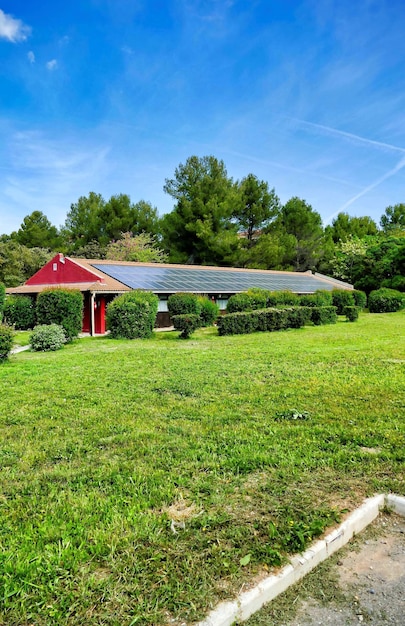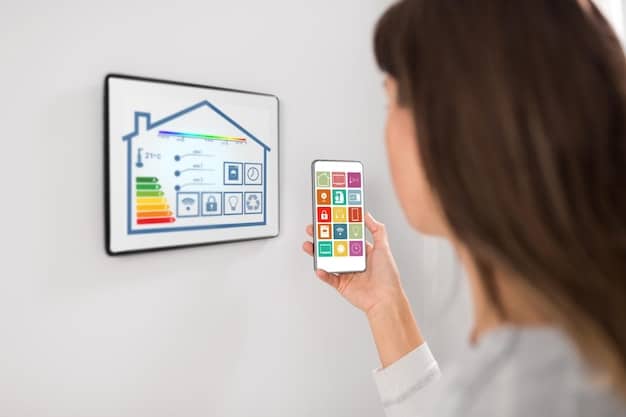New Federal Grants for Home Energy Efficiency: Check Your Eligibility in 2025

New federal grants are expected to become available in 2025, offering financial assistance to homeowners for energy-efficient upgrades that reduce energy consumption and lower utility bills.
Are you looking to make your home more energy-efficient while saving money? **New federal grants for home energy efficiency** are on the horizon for 2025, offering homeowners like you the opportunity to upgrade your homes and reduce your carbon footprint.
Understanding the Landscape of Federal Grants for Home Energy Efficiency
Federal grants play a crucial role in promoting energy efficiency across the United States. These initiatives are designed to encourage homeowners to invest in upgrades that not only lower their energy consumption but also contribute to a more sustainable environment. Understanding the scope and impact of these grants is the first step in taking advantage of them.
These grants often target specific areas of energy efficiency, such as insulation, heating and cooling systems, and renewable energy installations. By providing financial assistance, the government aims to make these upgrades more accessible to a wider range of homeowners, regardless of their income level.
The Role of Government Incentives
Government incentives, including grants and tax credits, are pivotal in driving the adoption of energy-efficient technologies. They help offset the initial costs associated with these upgrades, making them a more attractive investment for homeowners.
- Promote Sustainable Practices: Encouraging homeowners to adopt energy-efficient solutions.
- Reduce Energy Consumption: Lowering overall energy usage and dependence on fossil fuels.
- Stimulate Economic Growth: Creating jobs in the energy efficiency sector.
These incentives not only benefit individual homeowners but also contribute to broader national goals, such as reducing greenhouse gas emissions and enhancing energy security.

Historical Overview of Energy Efficiency Grants
Over the years, various federal programs have supported home energy efficiency. Examining these initiatives provides valuable insights into what works and what can be improved upon in future programs.
- Weatherization Assistance Program: Providing assistance to low-income families to improve their homes’ energy efficiency.
- Energy Efficiency Block Grant Program: Allocating funds to states and local governments for energy efficiency projects.
- Tax Credits for Energy Efficiency: Offering tax incentives for homeowners who invest in energy-efficient equipment.
These past programs have demonstrated the potential of government support in driving significant improvements in home energy efficiency. The lessons learned from these initiatives will help shape the design and implementation of future grant programs.
In conclusion, federal grants for home energy efficiency are a vital tool for promoting sustainable practices, reducing energy consumption, and stimulating economic growth. As we look ahead to 2025, understanding the landscape of these grants and their potential impact is essential for homeowners looking to improve their homes and contribute to a greener future.
Key Energy Efficiency Upgrades Covered by Federal Grants
Identifying which home upgrades qualify for federal grants is crucial for homeowners planning to improve their energy efficiency. While specific details may vary depending on the grant program, several common upgrades are typically covered.
Understanding these key upgrades can help homeowners prioritize their investments and maximize their chances of receiving grant funding. Knowing what is covered can also assist in planning a comprehensive energy efficiency strategy for your home.
Insulation Improvements
Proper insulation is essential for maintaining a comfortable indoor temperature and reducing energy loss. Grants often cover insulation upgrades in attics, walls, and basements.
- Attic Insulation: Preventing heat loss in the winter and heat gain in the summer.
- Wall Insulation: Reducing drafts and improving overall energy efficiency.
- Basement Insulation: Minimizing moisture and temperature fluctuations in basements.
Adequate insulation can significantly lower heating and cooling costs, making it a high-priority upgrade for many homeowners.
Heating and Cooling System Upgrades
Replacing outdated or inefficient heating and cooling systems with modern, energy-efficient models can lead to substantial energy savings. Grants often support the installation of high-efficiency furnaces, air conditioners, and heat pumps.
- High-Efficiency Furnaces: Providing reliable heating while consuming less energy.
- Energy-Efficient Air Conditioners: Cooling homes effectively with reduced electricity usage.
- Heat Pumps: Offering both heating and cooling solutions with high energy efficiency.
These upgrades not only lower energy bills but also enhance the comfort and air quality of your home.
Renewable Energy Installations
Installing renewable energy systems, such as solar panels and solar water heaters, can significantly reduce your reliance on traditional energy sources. Federal grants often provide financial assistance for these installations.
- Solar Panels: Generating electricity from sunlight, reducing your carbon footprint.
- Solar Water Heaters: Using solar energy to heat water, lowering water heating costs.
- Geothermal Systems: Utilizing the Earth’s natural heat for heating and cooling.
Renewable energy installations not only save money on energy bills but also contribute to a cleaner and more sustainable energy future.
In summary, federal grants for home energy efficiency typically cover a range of upgrades, including insulation improvements, heating and cooling system upgrades, and renewable energy installations. By focusing on these key areas, homeowners can improve their homes’ energy efficiency, reduce their energy costs, and contribute to a more sustainable environment.
Eligibility Criteria for 2025 Federal Energy Efficiency Grants
Understanding the eligibility criteria for federal energy efficiency grants is essential for homeowners who wish to apply. These criteria ensure that the grants are distributed fairly and effectively to those who need them most.
Eligibility requirements often consider factors such as income level, property type, and the specific energy efficiency upgrades being undertaken. Meeting these criteria is a prerequisite for receiving grant funding.
Income Requirements
Many federal grants have income limitations to ensure that the funds are directed to low- and moderate-income households. These income thresholds vary depending on the specific grant program and the location of the property.
Income limits can be based on the area median income (AMI) or other relevant benchmarks. Homeowners must provide documentation to verify their income level, such as tax returns and pay stubs.
Property Requirements
The type and location of the property can also affect eligibility for energy efficiency grants. Some programs may only be available to homeowners in certain geographic areas or to those who own specific types of properties, such as single-family homes or multi-family dwellings.
Additionally, the age and condition of the property may be considered. Older homes or those in need of significant repairs may be prioritized for grant funding.

Upgrade Requirements
The specific energy efficiency upgrades being undertaken must meet certain requirements to qualify for grant funding. These requirements may include using certified contractors, installing Energy Star-rated products, and achieving a certain level of energy savings.
Homeowners may need to obtain pre-approval for their proposed upgrades before beginning the work. This ensures that the upgrades meet the program’s requirements and are eligible for reimbursement.
In conclusion, eligibility for federal energy efficiency grants depends on various factors, including income level, property type, and the specific energy efficiency upgrades being undertaken. By understanding and meeting these criteria, homeowners can increase their chances of receiving grant funding and improving their homes’ energy efficiency.
How to Apply for Federal Grants: A Step-by-Step Guide
Applying for federal grants can seem daunting, but by following a systematic approach, homeowners can navigate the process more easily. This step-by-step guide outlines the key steps involved in applying for federal grants for home energy efficiency.
Understanding each step and preparing the necessary documentation can help ensure a smooth and successful application process. Thorough preparation is essential for maximizing your chances of receiving grant funding.
Step 1: Research Available Grants
The first step is to research the available federal grants for home energy efficiency. Several websites and resources can help you identify grant programs that are relevant to your situation.
- Energy.gov: The official website of the U.S. Department of Energy provides information on federal energy efficiency programs.
- Benefits.gov: A website that helps you determine your eligibility for various government benefits, including grants.
- State Energy Offices: Your state’s energy office can provide information on state and local grant programs.
Take the time to thoroughly research your options and identify the grants that best align with your needs and eligibility.
Step 2: Determine Eligibility
Once you have identified potential grant programs, carefully review the eligibility criteria to ensure that you meet the requirements. Pay close attention to income limits, property requirements, and upgrade specifications.
Gather the necessary documentation to verify your eligibility, such as tax returns, pay stubs, and property records. Being prepared with the right documents can save you time and effort later in the application process.
Step 3: Prepare Your Application
Prepare a comprehensive application that includes all the required information and documentation. Follow the instructions carefully and ensure that your application is complete and accurate.
Include detailed descriptions of the proposed energy efficiency upgrades, cost estimates, and any other information that may be relevant. A well-prepared application demonstrates your commitment to improving your home’s energy efficiency.
Step 4: Submit Your Application
Submit your application by the deadline specified in the grant program guidelines. Double-check that you have included all the required documents and that your application is complete.
Keep a copy of your application for your records. You may need to refer to it later in the application process.
Step 5: Follow Up
After submitting your application, follow up with the grant program to check on its status. Be patient, as the review process can take several weeks or months.
If your application is approved, follow the instructions for receiving your grant funding and completing the energy efficiency upgrades. If your application is denied, ask for feedback and consider reapplying in the future.
In conclusion, applying for federal grants for home energy efficiency requires careful research, preparation, and persistence. By following these steps, homeowners can increase their chances of receiving grant funding and improving their homes’ energy efficiency.
Maximizing Your Chances of Grant Approval
While there is no guarantee of grant approval, there are several strategies that homeowners can employ to maximize their chances of success. These strategies focus on demonstrating a clear need for the grant, aligning with the program’s goals, and presenting a well-prepared application.
By implementing these best practices, homeowners can significantly improve their odds of receiving grant funding and achieving their energy efficiency goals.
Demonstrate a Clear Need
Highlight the specific energy efficiency challenges that your home faces and how the proposed upgrades will address those challenges. Provide data and evidence to support your claims, such as energy bills and home energy audit reports.
Explain how the grant funding will help you overcome financial barriers to making these essential upgrades. Demonstrating a clear need can make your application more compelling.
Align with Program Goals
Carefully review the grant program’s goals and priorities and tailor your application to align with those objectives. Emphasize the benefits of your proposed upgrades in terms of energy savings, environmental impact, and community benefits.
Show how your project will contribute to the program’s broader goals, such as reducing greenhouse gas emissions, promoting renewable energy, and improving the quality of life for residents.
Present a Well-Prepared Application
Ensure that your application is complete, accurate, and well-organized. Follow the instructions carefully and provide all the required documentation. Proofread your application for errors and omissions.
Consider seeking assistance from a professional grant writer or energy efficiency expert to help you prepare a strong and persuasive application. A well-prepared application demonstrates your commitment to the project and increases your credibility.
Engage with Local Resources
Connect with local energy efficiency organizations, contractors, and community groups to learn about available resources and support. These resources can help you identify potential grant programs, prepare your application, and implement your project.
Attend workshops and seminars on energy efficiency and grant writing to enhance your knowledge and skills. Engaging with local resources can provide valuable insights and assistance.
In conclusion, maximizing your chances of grant approval requires demonstrating a clear need, aligning with program goals, presenting a well-prepared application, and engaging with local resources. By implementing these strategies, homeowners can significantly improve their odds of receiving grant funding and achieving their energy efficiency goals.
Future Trends in Federal Energy Efficiency Grants
As technology evolves and energy efficiency becomes an increasingly pressing concern, federal grant programs are likely to adapt and evolve as well. Understanding these future trends can help homeowners anticipate upcoming opportunities and plan their energy efficiency upgrades accordingly.
Several key trends are expected to shape the future of federal energy efficiency grants, including a greater emphasis on renewable energy, smart home technologies, and community-based projects.
Emphasis on Renewable Energy
Federal grants are likely to increasingly prioritize projects that incorporate renewable energy technologies, such as solar panels, solar water heaters, and geothermal systems. These technologies can significantly reduce reliance on fossil fuels and lower carbon emissions.
Grant programs may offer higher incentives for homeowners who install renewable energy systems or combine them with other energy efficiency upgrades.
Integration of Smart Home Technologies
Smart home technologies, such as smart thermostats, energy monitoring systems, and automated lighting controls, are becoming increasingly popular. These technologies can help homeowners optimize their energy consumption and reduce waste.
Future grant programs may encourage the integration of smart home technologies into energy efficiency projects by offering incentives for the installation and use of these systems.
Focus on Community-Based Projects
Community-based energy efficiency projects are likely to receive greater attention and support in the future. These projects involve multiple homeowners or community organizations working together to improve energy efficiency in a neighborhood or region.
Grant programs may offer funding for community-based projects that demonstrate innovative approaches to energy efficiency and have a significant impact on the community.
Data-Driven Decision Making
Data-driven decision making is becoming increasingly important in the energy efficiency sector. Grant programs may require homeowners to collect and analyze data on their energy consumption to inform their upgrade decisions and measure the impact of their projects.
This data can help homeowners optimize their energy efficiency strategies and demonstrate the effectiveness of their projects to grant administrators.
In conclusion, future trends in federal energy efficiency grants are likely to emphasize renewable energy, smart home technologies, community-based projects, and data-driven decision making. By staying informed about these trends, homeowners can position themselves to take advantage of upcoming opportunities and make the most of their energy efficiency investments.
| Key Point | Brief Description |
|---|---|
| 💡 Grant Eligibility | Income, property type, and upgrades influence eligibility. |
| 💰 Covered Upgrades | Insulation, HVAC systems, and renewable energy are often covered. |
| 🚀 Application Steps | Research, eligibility check, application, and follow-up. |
| 🌱 Future Trends | Renewable energy and smart home integration becoming key. |
Frequently Asked Questions
▼
Common upgrades include insulation, HVAC systems, smart thermostats, and renewable energy installations like solar panels. Check specific program guidelines for detailed coverage.
▼
Income requirements vary. Most programs use Area Median Income (AMI) as a benchmark. Provide tax returns and pay stubs to verify your income level.
▼
Check Energy.gov, Benefits.gov, and your state’s energy office. These resources provide information on federal and state programs that might be available.
▼
It depends on the guidelines of each grant program. Some allow stacking of funds, while others do not. Verify rules for each grant before applying.
▼
Typically, you’ll require proof of income (tax returns, pay stubs), property ownership documentation, and detailed cost estimates for the proposed upgrades.
Conclusion
As we look forward to 2025, understanding the opportunities presented by new federal grants for home energy efficiency is crucial for homeowners aiming to reduce their carbon footprint and save money. By staying informed, assessing eligibility, and preparing thoroughly, you can position yourself to take advantage of these valuable resources and make your home more sustainable.





